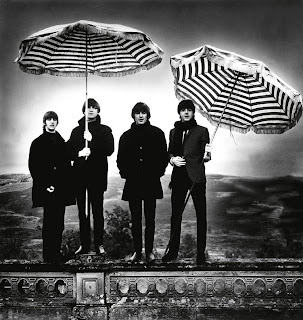 by Kathryn Hadley
by Kathryn Hadley‘Beatles to Bowie: The 60s Exposed’ opens tomorrow at the National Portrait Gallery to mark the 50th anniversary of the start of the 60s, next year. Showcasing over 150 portraits of the leading pop personalities of the 1960s and a range of memorabilia including record covers and magazines, the exhibition explores the pop scene of ‘Swinging London’. The display is divided into ten sections covering each year of the decade and includes classic images of bands such as The Beatles, the Rolling Stones, The Kinks and The Who, as well as previously unseen images.
The evolution of the art scene over the decade is striking: the style and techniques of photography changed, as well as, and almost in parallel with, pop music and culture. Most fascinating is the interaction between photography and the pop scene. To what extent did they evolve independently; how far did the two influence one another?
Photography evolved from static black and white portraits to dynamic and colourful photographs taken ‘on the spot’ and depicting artists in action, such as Fiona Adams’ iconic photograph of The Beatles jumping on a wall taken in 1963. The pop scene also became increasingly diverse in terms of style, culture and ethnicity, reflecting the cultural and social developments of the decade. Pure pop was replaced with progressive music and psychedelia and became influenced by new music styles as musicians such as Jemi Hendrix from the United States moved to England.

The exhibition is set against a background of music from the early and late sixties, which can be heard in two different areas of the display and illustrates this stylistic evolution over the course of the decade. A video in the section devoted to the late 1960s also brings some of these icons of the ‘Swinging Sixties’ to life.
The icons of the 1960s pop scene live on in the imagination of generations who were too young to see them perform live and in the memory of those who grew up at the time. The striking portraits on display in ‘Beatles to Bowie’ are a tribute to their influence on the British cultural scene. Despite the music playing in the background, the artists remain, however, surprisingly silent and the exhibition is slightly too static. My request to the disc jockey would be: turn the volume up and let the music play!
Beatles to Bowie: The 60s Exposed
Until January 24th
National Portrait Gallery
St Martin’s Place
London WC2H 0HE
Telephone: 020 7306 0055
http://www.npg.org.uk/
For further information on the history of music, here is a selection of some of our best articles:
20th century:
In ‘You Say You Want a Revolution’ Mikhail Safonov argues that the Beatles did more for the break up of totalitarianism in the USSR than Alexander Solzhenitsyn and Andrei Sakharov.
Rock 'n' Roll and Social Change Richard Welch charts the explosion of Rock n’ Roll in American music and argues for its impact on society as a whole.
In December 1970 Elvis Presley requested a meeting with President Richard Nixon. In Elvis: Rock‘n’Roll’s Reluctant Rebel Glen Jeansonne and David Luhrssen look at how the King of Rock’n’Roll managed his rule during the cultural shifts of the 1960s.
Django, Jazz and the Nazis in Paris John D. Pelzer charts the development of jazz in France and considers how it became a symbol of resistance to the Nazi regime during the German occupation.
19th century:
In Changing the Tune - Popular Music in the 1890s Ian Bradley considers what qualified as family favourites in the last decade of the nineteenth century. In Political Heroes of the Victorian Music Hall Michael Diamond discusses what popular songs and singers had to say about Britain's politicians in the 1880s and 1890s.
Images:
- The Beatles, 1963 by Fiona Adams (© Fiona Adams)
- Pink Floyd, 1967 by Vic Singh (© Vic Singh)

1 comment:
Oh joy, thanks for sharing. I love your blog.
All the very best,
Simone
Post a Comment